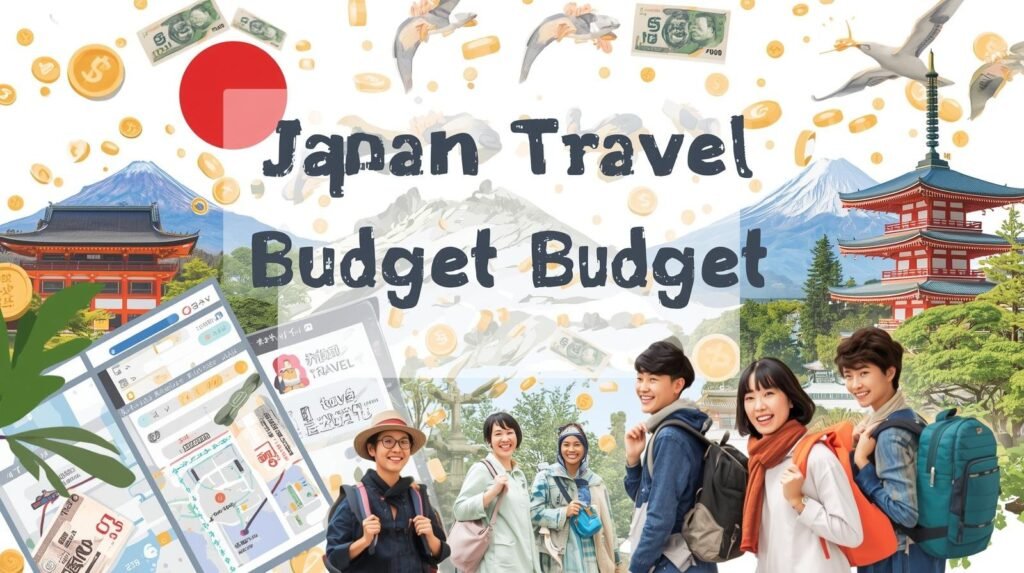Japan is often seen as an expensive destination, but with some careful planning and insider tips, you can explore this beautiful country without breaking the bank. From affordable transportation options to budget-friendly accommodations and discounts for attractions, there are plenty of ways to save money while still enjoying all that Japan has to offer. In this guide, we’ll show you how to make the most of your Japan travel budget. official Website.
Japan Travel Budget
Planning a Japan travel budget depends on your travel style. On average, backpackers spend around $70–$100 per day, while mid-range travelers may need $150–$250 daily. Costs include transportation (consider a JR Pass), accommodation, food, entrance fees, and shopping. Save by staying in hostels, eating at convenience stores or local eateries, and using regional rail passes. With smart planning, Japan offers incredible experiences without breaking the bank—whether you’re exploring cities or rural gems

1. Use Discount Passes for Transportation
In Japan, transportation costs can add up quickly, but using discount passes can save you a lot of money. Here’s a breakdown of some popular passes:
Popular Japan Travel Passes:
- JR Rail Pass: This pass is ideal for travelers who plan to explore different regions. For example, a 7-day JR Rail Pass costs around ¥29,110 (approximately ₹17,000 INR).
- Regional Passes: If you’re staying in one region, you can opt for a regional pass like the JR East Pass (5-day pass), which costs ¥20,000 (approximately ₹11,500 INR).
- Tokyo Metro Pass: A 24-hour Tokyo Metro pass costs about ¥600 (around ₹350 INR), which gives unlimited subway rides within Tokyo.
By using these passes, you can significantly lower transportation costs. For example, a single ride on the subway or JR trains in Tokyo can cost between ¥200 and ¥500 (₹115 to ₹290 INR), but with a day pass, you’ll only pay ¥600 (₹350 INR), and it’s unlimited! Read More.
2. Stay in Budget-Friendly Accommodations
Accommodation can be expensive in Japan, but you can find affordable places to stay. Here are some types of budget accommodations:

- Capsule Hotels: A capsule hotel costs around ¥2,000 – ¥4,000 per night (₹1,150 to ₹2,300 INR). These are compact sleeping pods ideal for solo travelers.
- Hostels: A bed in a dormitory-style hostel typically costs ¥3,000 – ¥5,000 per night (₹1,700 to ₹2,900 INR).
- Guesthouses/Ryokan: You can stay in traditional ryokan inns for around ¥5,000 – ¥7,000 per night (₹2,900 to ₹4,100 INR), which is a great way to experience Japanese culture.
- Airbnb: Renting a room or apartment via Airbnb can cost around ¥4,000 – ¥8,000 (₹2,300 to ₹4,600 INR) per night, depending on the location and type of property.
To save even more, consider booking accommodations in less touristy areas or the outskirts of cities. You’ll enjoy lower prices while still being close to transport links
3. Dining on a Budget
Food in Japan doesn’t have to be expensive if you choose wisely. Here’s a cost breakdown:
- Conveyor Belt Sushi (Kaiten-zushi): A plate of sushi can cost around ¥100-¥500. (₹60 to ₹290 INR) Depending on the restaurant.
- Ramen: A bowl of ramen in a local shop costs between ¥500 and ¥1,000 (₹290 to ₹580 INR).
- Convenience Store Meals: Japanese convenience stores like 7-Eleven, Lawson, and FamilyMart offer quick meals such as onigiri (rice balls), sandwiches, and even instant ramen for about ¥100-¥500 (₹60 to ₹290 INR).
- Street Food: Popular street foods like takoyaki (octopus balls), okonomiyaki (savory pancakes), and yaki imo (roasted sweet potatoes) usually cost between ¥300 and ¥800 (₹170 to ₹460 INR).
With these affordable options, you can easily keep your food costs under control. If you’re on a tight budget, spending about ¥1,500-¥2,500 (₹860 to ₹1,450 INR) per day for food should suffice.
4. Visit Free or Low-Cost Attractions
Japan offers a wide variety of free or low-cost attractions, so you can enjoy the country’s beauty without spending much:

- Parks and Gardens: Visiting parks such as Ueno Park (Tokyo) or Maruyama Park Kyoto is free, and they offer scenic views and cultural experiences.
- Temples and Shrines: Major temples and shrines, like Senso-ji Temple (Tokyo) and Fushimi Inari Taisha (Kyoto), are free to enter. Some temples may have a small fee (typically ¥300-¥500 or ₹170-₹290 INR) for special areas, but the main grounds are free.
- Street Festivals: If you visit during festival seasons, you can enjoy many cultural events, performances, and parades for free. Popular festivals like Hanami (cherry blossom viewing) and Tanabata offer a vibrant experience at no cost.
These free attractions will allow you to experience Japan’s cultural richness without spending a dime.
5. Shop Smart: Discount Stores & Local Markets
Japan has some excellent discount stores where you can pick up affordable souvenirs and other goods:
- 100 Yen Shops: Stores like Daiso and Seria sell items for ¥100 (around ₹60 INR), including souvenirs, snacks, and household goods. This is a great place for budget-friendly shopping.
- Department Store Sales: Take advantage of seasonal sales in department stores like Takashimaya and Isetan, where you can find discounts of up to 50% off on fashion, electronics, and accessories.
- Local Markets: Explore markets like Ameyoko (Tokyo) or Nishiki Market (Kyoto) for affordable souvenirs, food, and local products. You can find items at prices starting from ¥100 (₹60 INR).
6. Travel Off-Peak for Better Deals
To save even more money, consider traveling during Japan’s off-peak seasons. The most affordable months are usually winter (December to February) and the early spring before cherry blossom season (March to early April). During these times, you’ll find:

- Cheaper flights: Airfares tend to be lower in winter and early spring, especially after the New Year.
- Discounted hotel rates: Hotel prices drop in off-peak months, with savings of 20%-30% compared to peak season.
- Less crowded attractions: You can enjoy popular sites without the heavy tourist crowds.
Frequently Asked Questions (FAQs)
- Can I travel to Japan on a budget?
Yes, it’s definitely possible! By using discount transportation passes, staying in budget accommodations, eating at affordable spots, and visiting free attractions, you can enjoy Japan without spending too much. - What are the cheapest transportation options in Japan?
Consider purchasing Japan Rail Passes or regional travel passes for unlimited rides. Subways, buses, and local trains are more affordable than the high-speed Shinkansen. - How much should I budget for food in Japan?
On average, budget travelers can expect to spend around ¥2,000 to ¥3,000 per day (approximately $18 to $27 USD) on food, depending on where and what you eat. - What is the best way to save on accommodation?
To save on accommodation, opt for capsule hotels, hostels, or consider staying in guesthouses. You can also rent through Airbnb for a more local experience. - Is Japan expensive for tourists?
Japan can be expensive, but it’s possible to travel on a budget by planning ahead, using discount passes, choosing affordable dining options, and staying in budget-friendly accommodations.
Conclusion
Traveling in Japan on a budget is absolutely achievable with the right planning and knowledge. Whether it’s finding affordable accommodation, using discount passes for transportation, or exploring free attractions, there are many ways to make the most of your budget. Follow these tips, and you’ll be able to enjoy Japan’s rich culture, stunning landscapes, and vibrant cities without breaking the bank!

